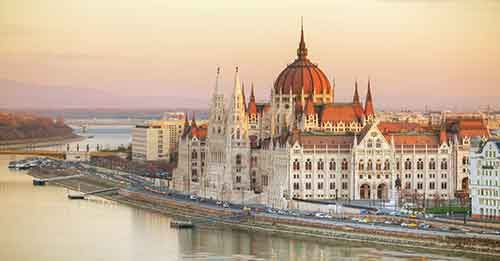
Budapest
Regardless of whether you travel on a short or longer Hungary river cruise, seeing Budapest is a must-do destination. Budapest is a burgeoning food and beer capital – one that features "Ruins Bars" and the largest synagogue in Europe – a Moorish Revival styled building that was constructed from 1854 to 1859.
Best Time to Visit
A great time to see Budapest is during Oktoberfest when the city's beer fest is held in Kincsem Park. Shoulder season is the preferred travel time, or from March through May or September through November. At those times, the river cruise prices are lower as well as the temperatures.
You Should Know
If you are younger and more energetic, you may be interested in visiting a ruin bar (a romkocsma concept). Ruin bars represent makeshift pubs set up in run-down pre-war buildings that feature furniture from clearance sales. Szimpla Kert is one of the more iconic examples of the "ruin bar" idea. Budapest has the oldest subway in Continental Europe – an underground rail system that has been operating since 1896. The city offers free public transportation to travelers and locals 65+ years old. This includes the subway,above-ground trains, chair-lifts, the funicular, and boat trips for free.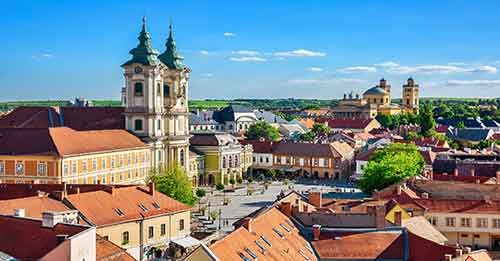
Eger, Hungary
Eger is a popular city to visit on in-country river cruises. The city, which sits in northern Hungary, is home to Eger Castle and Eszterhazy Karoly College. The tree-shaded Kossuth Lajos Street reveals much about this city's history with its old buildings and wrought-iron gate in front of the County Building.
Best Time To Visit
Plan to visit Eger on a shorter river cruise from March through May or from September through November.
You Should Know
Eger Castle overlooks Eger and is located across the Eger River. The Istvan Dobo Castle Museum at the site features castle exhibits and a picture gallery. Eger red wines are popular wines, savored in Hungary and around the world.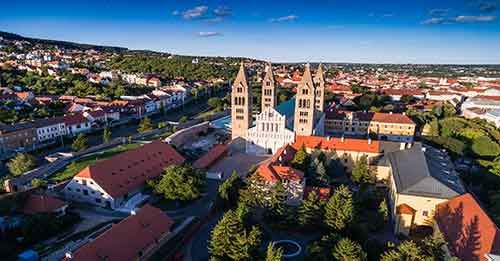
Pecs, Hungary
If you limit river cruise travel to Hungary, Pecs is a must-see location. You will have plenty of historic sites to view and restaurants to visit. The quiet town will lull you into its surreal atmosphere – an escape to a faraway time and place.
Best Time To Visit
You can enjoy Pecs at any time of the year, but it is best to go, from a cost standpoint, during the spring or fall.
You Should Know
The Basilica of St. Peter in Pecs features four towers and dates back to the 11th century. Three of the chapels—the Chapel of the Sacred Heart, the Chapel of St. Mary, and Mor Chapel feature the artwork of Bertalan Szekely. The top square in Pecs, the sloped Szechenyi ter, boasts large baroque buildings and is at the center of people-watching activities. The Zsolnay Fountain in the square displays an eosin glaze or a metallic and iridescent sheen that people either like or hate.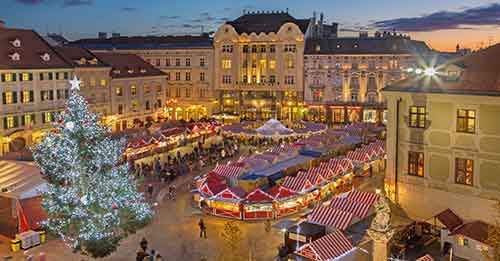
Bratislava, Slovakia
Lying along the
Danube River, the Slovakian capital is bordered by Hungary and Austria. Surrounded by the Little Carpathian Mountains and featuring cycling and hiking trails, the town is also known for its lively eateries and bars. Built in the 1700s, the pedestrian-only capital proves ideal for walking and seeing the sites up-close.
Best Time To Visit
Keep your calendar open for traveling from March through May or from September through November.
You Should Know
The tower of Michael's Gate is the only remaining medieval gate in the capital. To see a city view, climb to the top of the tower. The structure was built in the 14th century. Step back in time by strolling down peaceful, medieval Kapitulska Street. Visit Bratislava Castle, but skip the tour. Instead, see the view at the top.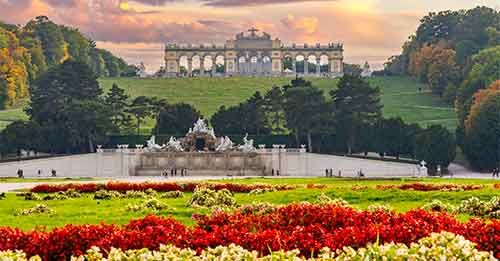
Vienna, Austria
Situated on the Danube River, the capital of
Austria dates back to Roman times, when Romans founded the military camp of Vindobona. Today, the cityscape is defined by baroque buildings, most of which were created under the reign and influence of Maria Theresia (from 1740 to 1780) and Franz Joseph, who ruled from 1848 to 1916.
Best Time To Visit
According to U.S. News Travel, it is best to visit Vienna in the spring or fall when the crowds and temperatures are lower.
You Should Know
The former imperial summer estate, Schloss Schonbrunn, features beautiful formal gardens and a zoo. The Hofburg, or Imperial Palace, on the grounds served as a home base for the Habsburgs over a span of 6 centuries. The baroque building, Belvedere Palace, contains Osterreichische Galerie. The gallery displays the largest representation of works by the Austrian artists, Oskar Kokoschka and Gustav Klimt. Prime landmarks include the gothic St. Stephen's Cathedral and the large Ferris wheel, located in the Prater (an old amusement park).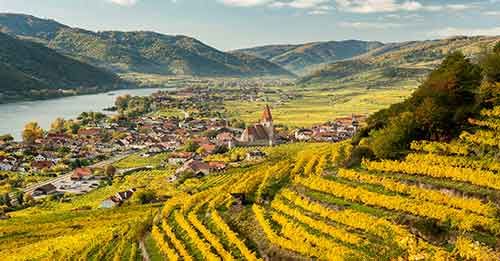
Wachau Valley
A scenic vista along the Danube River, the Wachau Valley nestles between the towns of Melk and Krems and stretches 18 miles. The historic valley is known for its memorable wines and its outdoor activities, especially hiking and cycling.
Best Time To Visit
Visit the Wachau Valley is during the spring or fall, or when you can see the vineyards and sights with fewer distractions.
You Should Know
Take a day excursion during a port stopover at Krems, and cycle or hike through the Wachau Valley. Krems is a town also known for its wine tastings. In addition, you can cycle from Krems to the town of Melk during an offshore excursion - a journey of about 20 miles. Bike along either side of the Danube River. The north bank features more villages while the south bank is less crowded.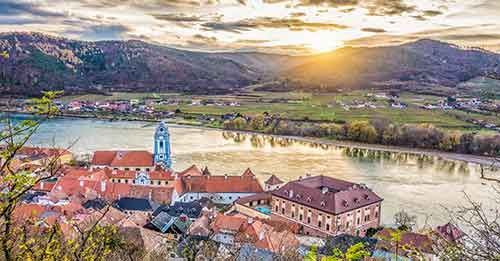
Durnstein, Austria
Another town near the Wachau Valle, Durnstein is a charming and friendly stopover. The river town is full of history and culture. Durnstein is where Richard the Lionhearted was imprisoned by Austria's king. You can access the ruins from town, although you will face a somewhat steep climb. If you want to forego the climb, you can see the sites of the town up-close, including historic monuments, wine houses, and colorful buildings.
Best Time To Visit
Plan to visit Durnstein when the weather is balmier, or from March to May or September through November.
You Should Know
While you won't see much if you visit the ruins of Castle Durnstein, the site's position, high atop a hill, will give you a great view of the town below. Richard the Lionhearted was imprisoned at the site from December 1192 to March 1193. Walking along the Danube River in Durnstein allows you to escape to another time and see some of the town's memorable historic sites, including the Stift Durnstein monastery's church tower. The gothic and baroque styled monastery was built between 1400 and 1700.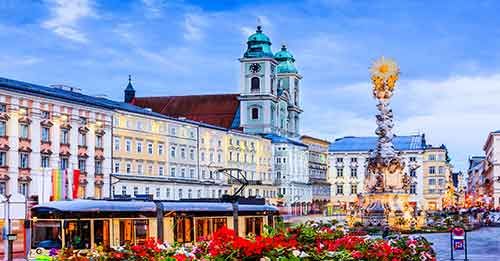
Linz, Austria
The capital of Upper Austria, central Linz, is frequently included on Hungary river cruises from Vienna to Budapest or vice versa. The city's mix of stunning architecture, historical structures, and green space offers visitors a chance to see a large number of interesting sites.
Best Time To Visit
You will be rewarded with sunshine, cooler temperatures, and fewer crowds if you plan a shoulder season visit from March through May or from September to November.
You Should Know
The Austrian architect, Johann Michael Pruner, managed much of the construction of Linz in the early part of the 1700s. The Trinity Column, at the time, was erected in the main square – celebrating the fact that Linz had been spared of the plague. Situated 75 miles west of Linz, Braunau am Inn was the birthplace of a tyrannical dictator, Adolph Hitler, who spent a large part of his childhood in Linz. Hitler, who was born in 1889, moved to Vienna from Linz in 1907.
Getting There
Embarking on a Hungary river cruise typically begins in Budapest, the country's vibrant capital situated on the
Danube River. Geographically, Hungary is nestled in Central Europe, making it easily accessible from various European cities. Budapest's central location along the Danube makes it an ideal starting or ending point for river cruises.
For international travelers, Budapest Ferenc Liszt International Airport is the main gateway, well-connected with flights from across the globe. From the airport, the city center is a short ride away, where the main cruise ports are located. These ports along the Danube are well-equipped to welcome river cruise ships, offering easy access for boarding. The central location of these ports also means you're just steps away from starting your exploration of Budapest's rich history and culture.
The Perfect Time for a Hungary River Cruise
When planning a river cruise in Hungary, it's important to consider both the weather and the level of tourist activity you prefer. Hungary's continental climate results in distinct seasons, each offering a unique river cruising experience.
Spring, from April to June, is a particularly delightful time for a river cruise in Hungary. During these months, the weather is typically mild, and the landscape along the Danube River starts to flourish with blooming flowers, enhancing the beauty of the cruise. Moreover, the spring season precedes the peak tourist rush, allowing for a more peaceful experience.
The summer months of July and August in Hungary are known for their warmer temperatures, making it an excellent time for sunbathing on the deck and enjoying the vibrant outdoor life. However, this period also coincides with the peak tourist season. Cities like Budapest, a key highlight of many Hungary river cruises, become quite lively, but also more crowded.
Autumn, spanning September to October, brings cooler weather and the stunning transformation of leaves, creating a picturesque setting for river cruising in Hungary. This season is less crowded, offering a more tranquil river cruising experience compared to the bustling summer months.
Winter, from November to March, tends to be chilly and can sometimes be snowy, lending a magical atmosphere to the river, particularly around Christmas with Hungary's festive markets. However, travelers should note that river cruise options may be more limited during this off-season period.
For those seeking a balance between enjoyable weather and fewer tourists, late spring and early autumn are the optimal times for a river cruise in Hungary. These seasons offer pleasant conditions and a more relaxed cruising experience, allowing travelers to fully appreciate the beauty and culture along Hungary's famous
Danube River.
Experience the Flavors of Hungary on a River Cruise
A river cruise through Hungary offers more than just scenic beauty; it's a journey into the heart of Hungarian culinary tradition. The country's cuisine is famously rich and hearty, characterized by its love for flavors, especially the iconic paprika. A dish you absolutely must try is Goulash, Hungary's national dish, a comforting stew made with beef, vegetables, and a generous amount of paprika. For a quick, savory bite, Lángos is a popular choice. This deep-fried flatbread, often topped with sour cream and cheese, is a street food staple. Another classic is Chicken Paprikash, a creamy, paprika-rich chicken dish served with dumplings known as nokedli, offering a true taste of Hungary's culinary heritage. For dessert, the spiral-shaped Chimney Cake, or Kürtoskalács, coated with sugar and often cinnamon or nuts, is an irresistible sweet treat.
When it comes to dining, traditional restaurants in Budapest or the bustling Great Market Hall are perfect spots to savor these delights. Your river cruise will likely offer a chance to sample these dishes, too, along with other Hungarian specialties. To perfectly complement your meal, a glass of Tokaji wine from Hungary's renowned Tokaj wine region is a must-try. This river cruise is not just a passage through Hungary's landscapes but an indulgence in the rich, flavorful world of its cuisine.
Immerse Yourself in Hungarian Culture
Exploring Hungary through a river cruise provides a unique opportunity to immerse yourself in its rich and diverse culture. Hungarian culture is deeply rooted in tradition, with a history that blends Eastern and Western influences. One of the most noticeable aspects is the country's music and dance, particularly its folk traditions. These are often showcased in festivals or local performances, where the vibrant folk costumes and energetic dances are a sight to behold.
Festivals play a significant role in Hungarian life, with various celebrations occurring throughout the year. Notable ones include the Budapest Spring Festival, showcasing a range of arts and music, and the colorful Sziget Festival, one of Europe's largest music and cultural events. Additionally, the country's rich history is evident in its architecture, from Roman ruins to Ottoman-era thermal baths, offering a window into the past.
In terms of customs, Hungarians are known for their hospitality and enjoy sharing their culture with visitors. A simple greeting in Hungarian, like "Jó napot" (Good day), is appreciated. These cultural experiences, combined with the stunning scenery and rich history encountered on a Hungary river cruise, make for an unforgettable journey.
Why Book a River Cruise to Hungary?
Booking a river cruise to Hungary is an excellent way to explore this central European gem. One of the biggest advantages of a river cruise is the unparalleled convenience it offers. Imagine unpacking once and relaxing in your floating hotel as you travel from one fascinating destination to the next. Each day brings a new location to explore without the hassle of changing accommodations or dealing with the logistics of land travel.
The value for money is another significant benefit. Your cruise typically includes meals, accommodations, and various sightseeing tours, which can be more cost-effective than arranging everything separately. Plus, cruising along the Danube offers unique views and perspectives of Hungary's stunning landscapes and cityscapes, which you might not experience from land.
Additionally, river cruises often provide exclusive access to certain areas and activities. This could include private tours of historical sites, special onboard cultural experiences, or even visits to attractions that are off the beaten path. These unique experiences add an element of exclusivity and depth to your travel adventure.
Ready to Book Your Hungary River Cruise?
Are you considering a river cruise through Hungary? It's an excellent choice for a unique and memorable vacation. Sailing along the Danube, you'll experience the best of Hungary's stunning landscapes, rich history, and vibrant culture. From the iconic sights of Budapest, like the Parliament Building and Buda Castle, to the serene beauty of the Hungarian countryside, each day brings new discoveries.
Hungarian cuisine will delight your taste buds with its hearty flavors, and the country's music and dance will add a lively dimension to your journey. Plus, the chance to immerse yourself in local customs and festivals makes this more than just a trip—it's a cultural experience.
Booking a Hungary river cruise is your ticket to an adventure filled with scenic beauty, historical treasures, and cultural richness. Whether you're a history buff, a nature lover, or a culinary enthusiast, Hungary offers something for everyone. So why wait? Book your cruise and get ready to explore the heart of Hungary from the majestic Danube.













 1. Free Quote
1. Free Quote 2. Dedicated Travel Consultant
2. Dedicated Travel Consultant 3. Low Price Guaranteed
3. Low Price Guaranteed 4. Stress Free Travel
4. Stress Free Travel

